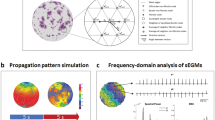Abstract
Atrial fibrillation (AF) is a very common, multifaceted disease that affects atrial structure as well as electrophysiological and biomechanical function. However, the mechanistic links between structural and functional factors underlying AF are poorly understood. To explore these mechanisms, a 3D atrial electro-mechanical (EM) model was developed that includes 3D atrial geometry based on the Visible Female dataset, rule-based fibre orientation, CRN human atrial electrophysiology model and activation-based mechanical contraction model. Electrical activation in the 3D atria was simulated under control condition and two AF scenarios: sinus rhythm (SR), functional re-entry in the right atrium (RA) and structural re-entry around fibrotic patches in the left atrium (LA). Fibrosis distributions were obtained from patient LGE MRI data. In both AF scenarios, re-entrant behaviours led to substantial reductions in the displacement at peak contraction compared to SR. Specifically, high-frequency re-entry led to a decrease in maximal displacement from 6.8 to 6.1 mm in the posterior RA, and a larger decrease from 7.8 to 4.5 mm in the LA in the presence of fibrotic patches. The simulated displacement values agreed with available clinical data. In conclusion, the novel model of EM coupling in the 3D human atria provided new insights into the mechanistic links between atrial electrics and mechanics during normal activation and re-entry sustaining AF. Re-entry in the RA and LA resulted in weaker contractions compared to SR, with additional effect of fibrosis on the atrial wall stiffness further reducing the contraction.
Access this chapter
Tax calculation will be finalised at checkout
Purchases are for personal use only
Similar content being viewed by others
References
Nattel, S.: New ideas about atrial fibrillation 50 years on. Nature 415, 219–226 (2002)
Camm, A.J., Kirchhof, P., Lip, G.Y.H., Schotten, U., Savelieva, I., et al.: Guidelines for the management of atrial fibrillation. Eur. Heart J. 31, 2369–2429 (2010)
Ball, J., Carrington, M.J., McMurray, J.J.V., Stewart, S.: Atrial fibrillation: profile and burden of an evolving epidemic in the 21st century. Int. J. Cardiol. 167, 1807–1824 (2013)
Pandit, S.V., Jalife, J.: Rotors and the dynamics of cardiac fibrillation. Circ. Res. 112, 849–862 (2013)
Morgan, R., Colman, M.A., Chubb, H., Seemann, G., Aslanidi, O.V.: Slow conduction in the border zones of patchy fibrosis stabilizes the drivers for atrial fibrillation: insights from multi-scale human atrial modeling. Front. Physiol. 7, 474 (2016)
Zahid, S., et al.: Patient-derived models link re-entrant driver localization in atrial fibrillation to fibrosis spatial pattern. Cardiovasc. Res. 110, 443–454 (2016)
Krueger, M.W., et al.: Modeling atrial fiber orientation in patient-specific geometries: a semi-automatic rule-based approach. In: Metaxas, D.N., Axel, L. (eds.) FIMH 2011. LNCS, vol. 6666, pp. 223–232. Springer, Heidelberg (2011). https://doi.org/10.1007/978-3-642-21028-0_28
Fang, Q., Boas, D.A.: Tetrahedral mesh generation from volumetric binary and gray-scale images. In: Proceedings Sixth IEEE International Conference Symposium Biomedical Imaging: From Nano to Macro, pp. 1142–1145 (2009)
Courtemanche, M., Ramirez, R.J., Nattel, S.: Ionic mechanisms underlying human atrial action potential properties: insights from a mathematical model Ionic mechanisms underlying human atrial action potential properties: insights from a mathematical model. Am. Physiol. Soc. 275, H301–H321 (1998)
Holzapfel, G.A., Ogden, R.W.: Constitutive modelling of passive myocardium. Philos. Trans. R. 367, 3445–3475 (2009)
Pironet, A., et al.: Simulation of left atrial function using a multi-scale model of the cardiovascular system. PLoS One 8(6), e65146 (2013)
Leischik, R., et al.: Echocardiographic evaluation of left atrial mechanics: function, history, novel techniques, advantages, and pitfalls. Biomed. Res. Int. 2015, 1–12 (2015)
Cambier, B.A., et al.: Influence of the breathing mode on the time course and amplitude of the cyclic inter-atrial pressure reversal in postoperative coronary bypass surgery patients. Eur. Heart J. 14, 920–924 (1993)
Lee, J., et al.: Multiphysics computational modeling in CHeart. SIAM J. Sci. Comput. 38, 150–178 (2016)
Issa, O., et al.: Left atrial size and heart failure hospitalization in patients with diastolic dysfunction and preserved ejection fraction. J. Cardiovasc. Echogr. 27, 1 (2017)
Lemery, R., et al.: Normal atrial activation and voltage during sinus rhythm in the human heart: an endocardial and epicardial mapping study in patients with a history of atrial fibrillation. J. Cardiovasc. Electrophysiol. 18, 402–408 (2007)
Haïssaguerre, M., et al.: Spontaneous initiation of atrial fibrillation by ectopic beats originating in the pulmonary veins. N. Engl. J. Med. 339, 659–666 (1998)
Quintana, M., et al.: Assessment of atrial regional and global electromechanical function by tissue velocity echocardiography: a feasibility study on healthy individuals. Cardiovasc. Ultrasound. 3, 1–12 (2005)
Patel, A.R., et al.: Cardiac cycle-dependent left atrial dynamics: implications for catheter ablation of atrial fibrillation. Hear. Rhythm. 5, 787–793 (2008)
Adeniran, I., Maciver, D.H., Garratt, C.J., Ye, J., Hancox, J.C., Zhang, H.: Effects of persistent atrial fibrillation- induced electrical remodeling on atrial electro-mechanics - insights from a 3D model of the human atria. PLoS One 10 (2015)
Colman, M.A., et al.: Pro-arrhythmogenic effects of atrial fibrillation-induced electrical remodelling: insights from the three-dimensional virtual human atria. J. Physiol. 591, 4249–4272 (2013)
Aslanidi, O.V., et al.: Heterogeneous and anisotropic integrative model of pulmonary veins: computational study of arrhythmogenic substrate for atrial fibrillation. Interface Focus. 3, 20120069 (2013)
Varela, M., et al.: Novel MRI technique enables non-invasive measurement of atrial wall thickness. IEEE Trans. Med. Imaging. 36, 1607–1614 (2017)
Acknowledgements
This work was supported by the Engineering and Physical Sciences Research Council (EPSRC) [EP/L015226/1], the British Heart Foundation [PG/15/8/31138] and the Wellcome/EPSRC Centre for Medical Engineering [WT 203148/Z/16/Z].
Author information
Authors and Affiliations
Corresponding author
Editor information
Editors and Affiliations
Rights and permissions
Copyright information
© 2019 Springer Nature Switzerland AG
About this paper
Cite this paper
Monaci, S., Nordsletten, D., Aslanidi, O. (2019). Computational Modelling of Electro-Mechanical Coupling in the Atria and Its Changes During Atrial Fibrillation. In: Pop, M., et al. Statistical Atlases and Computational Models of the Heart. Atrial Segmentation and LV Quantification Challenges. STACOM 2018. Lecture Notes in Computer Science(), vol 11395. Springer, Cham. https://doi.org/10.1007/978-3-030-12029-0_12
Download citation
DOI: https://doi.org/10.1007/978-3-030-12029-0_12
Published:
Publisher Name: Springer, Cham
Print ISBN: 978-3-030-12028-3
Online ISBN: 978-3-030-12029-0
eBook Packages: Computer ScienceComputer Science (R0)




